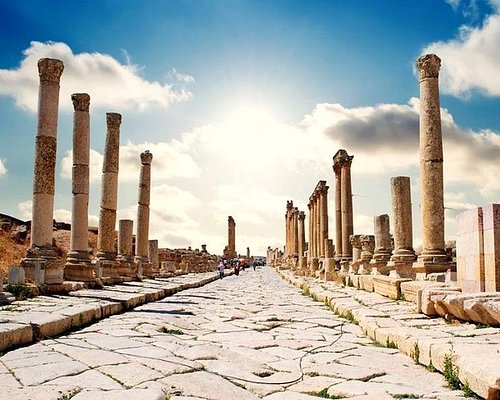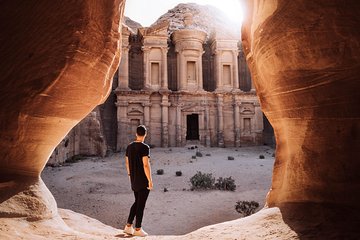Top Day Trips from Amman: Hidden Gems You Can Visit on a Jordan Tour
Introduction
Overview of Amman as a Tourist Destination
Amman, the capital of Jordan, stands as a vibrant testament to the country’s rich history, blending ancient ruins with modern living. Known for its friendly atmosphere, Amman welcomes visitors with warm hospitality and a diverse cultural scene. Attractions such as the Citadel, Roman Theatre, and the buzzing markets offer glimpses into both the past and present. This bustling city serves as an ideal starting point for exploring the treasures of Jordan, enticing travellers with its unique charm.
Highlights of Amman include:
- The Citadel: Dating back to the Bronze Age, it offers panoramic views of the city.
- Roman Theatre: A spectacular relic of Roman architecture, still used for events today.
- Rainbow Street: A lively area filled with cafes, shops, and art galleries.
Importance of Exploring Day Trips from Amman
Venturing beyond Amman enhances any travel itinerary, unlocking an array of remarkable day trips that showcase Jordan's diverse landscape and historical depth. Each excursion offers unique experiences that cater to various interests, from archaeology to natural wonders.
Consider the following reasons to explore day trips from Amman:
- Diverse Landscapes: From the arid beauty of Wadi Rum to the stunning waters of the Dead Sea, each destination offers breathtaking vistas.
- Rich History: Sites like Jerash and Petra provide unparalleled insights into the ancient world.
- Cultural Immersion: Regions such as Madaba and Mount Nebo offer a chance to engage with local cultures and traditions.
These day trips not only enrich a visit to Jordan but also allow travellers to delve deeper into the country's fascinating heritage, making the capital city a gateway to unforgettable discoveries.

Jerash
History and Significance of Jerash
Jerash, known as Gerasa in ancient times, is one of the best-preserved Greco-Roman cities in the world. Nestled just a short drive from Amman, it bears witness to centuries of history, with its origins dating back to 3200 BC. Throughout its turbulent past, Jerash has been influenced by various civilizations, including the Greeks, Romans, and Byzantines.
The significance of Jerash lies not only in its architectural grandeur but also in its historical context. Once a thriving Roman city on the Decapolis trade route, Jerash played a crucial role in commerce and culture. The ruins showcase the incredible engineering feats of the time, with intricate details and designs that continue to amaze visitors today.
Must-See Attractions in Jerash
When visiting Jerash, numerous attractions beckon exploration, each telling a part of the city's story:
- The Hadrian’s Arch: This monumental gateway welcomes visitors, paying homage to Emperor Hadrian, who visited Jerash in 129 AD.
- The Oval Plaza: Surrounded by 56 Ionic columns, this public space offers a striking view, perfect for photographs.
- The Temple of Artemis: Dedicated to the goddess of hunting, this grand temple showcases magnificent Corinthian columns and intricate carvings.
- The Roman Theatre: With a seating capacity of approximately 3,000, this theatre hosts events that revive the vibrant spirit of ancient performances.
Exploring Jerash is akin to wandering through a living museum, where each column and pathway tells tales of a bygone era. Visitors can easily lose track of time as they marvel at the impressive ruins and imagine the bustling life that once thrived within these ancient walls.

Dead Sea
Unique Characteristics of the Dead Sea
The Dead Sea is truly a natural wonder, known for its remarkable features that set it apart from any other body of water. As the Earth's lowest elevation on land, lying more than 400 meters below sea level, it is renowned for its mineral-rich waters and extreme salinity — offering a unique floating experience that is impossible to replicate elsewhere.
Some defining characteristics include:
- High Salinity: With a salinity of over 30%, the Dead Sea’s water is almost ten times saltier than most oceanic waters, creating a buoyant environment where swimmers can effortlessly float.
- Mineral-Rich Mud: The therapeutic mud, packed with minerals such as magnesium and potassium, is famous for its skin-soothing properties and is a highlight for wellness enthusiasts.
- Unique Ecosystem: With no outlet to the ocean, the Dead Sea’s harsh conditions mean that aquatic life is sparse, giving it its name; however, it is home to numerous mineral deposits.
Activities and Experiences at the Dead Sea
Experiencing the Dead Sea extends beyond floating on its surface; a myriad of activities awaits visitors, seeking both relaxation and adventure.
- Floating in the Water: The most iconic activity is simply floating, taking in the breathtaking views while reading a book or soaking up the sun.
- Mud Treatments: Participating in a mud bath is a must for any visitor. Applying the black mineral-rich mud can enhance skin texture and provide a natural glow.
- Wellness Resorts: Many resorts along the coast of the Dead Sea offer spa treatments that incorporate water and mud, providing rejuvenating experiences that cater to wellness seekers.
- Sunset Views: Watching the sun descend behind the mountains creates a magical atmosphere, with breathtaking reflections on the water’s surface.
The Dead Sea is more than just a destination — it is a sanctuary where visitors can unwind, indulge in unique treatments, and bask in the extraordinary beauty of one of nature's most unique landscapes.

Petra
Introduction to Petra's Ancient City
Petra, often referred to as the "Rose City" due to the stunning rose-red sandstone that characterises its architecture, stands as an iconic symbol of Jordan's rich heritage. This UNESCO World Heritage Site, carved into rocky cliffs by the Nabataeans over 2,000 years ago, was once a thriving hub of trade and culture, connecting the East and West. As visitors approach via the Siq — a narrow gorge that serves as the main entrance — anticipation builds with each step taken into the heart of this extraordinary ancient city.
Highlights of Petra include:
- Architectural Marvels: The immersive experience of walking through the Siq, with its towering cliffs, leads to impressive structures that showcase the ingenuity of the Nabataeans.
- Cultural Significance: The city's historical importance as a trade route has left an indelible mark on the region’s cultural tapestry.
Exploring the Monastery and Treasury in Petra
Two of the most renowned structures within Petra are the Treasury (Al-Khazneh) and the Monastery (Ad-Deir), each a masterpiece reflecting the artistry and engineering prowess of the Nabataeans.
- The Treasury (Al-Khazneh): Recognised for its majestic façade featuring intricate carvings, the Treasury is often the first iconic sight that leaves visitors awestruck. This tomb was believed to be the final resting place of a Nabataean king, showcasing elaborate architectural details and stunning pillars.
- The Monastery (Ad-Deir): A bit of a hike from the main complex, the Monastery is well worth the effort. Standing at 50 meters high and 45 meters wide, its grand scale and serene surroundings offer a perfect picture of the splendour that defined Petra.
Exploring these monumental sites allows visitors to connect not only with the artistry of the past but also to appreciate the historical significance that has made Petra a must-visit destination. Whether standing in admiration at the Treasury or soaking in the tranquillity around the Monastery, the experience remains etched in memory long after the visit ends.

Wadi Rum
Beauty and Grandeur of Wadi Rum Desert
Wadi Rum, often referred to as the "Valley of the Moon," captivates visitors with its breathtaking natural beauty and dramatic landscapes. This UNESCO World Heritage Site is characterised by towering sandstone mountains, narrow canyons, and sprawling red desert plains, creating an otherworldly experience that feels like stepping into a cinematic masterpiece. The stunning contrasts of colour, especially at sunrise and sunset, transform the desert into a painter’s palette, enticing photographers and nature lovers alike.
Key features that define Wadi Rum include:
- Unique Rock Formations: The iconic rock bridges and towering cliffs, sculpted by the wind and elements, create striking visual landscapes.
- Endless Sky: At night, the desert sky becomes a dazzling display of stars, offering one of the best views of the Milky Way away from city lights.
Camping and Jeep Tours in Wadi Rum
To truly embrace the splendour of Wadi Rum, engaging in camping or Jeep tours is essential.
- Camping Under the Stars: Spending a night in a traditional Bedouin camp allows visitors to immerse themselves in the culture and experience authentic hospitality. Here, guests can enjoy traditional meals while listening to stories of the desert, surrounded by the serene beauty of the landscape.
- Jeep Tours: For those looking to explore more of Wadi Rum, guided Jeep tours provide an exhilarating way to navigate the rugged terrain. Adventure seekers can discover hidden canyons, ancient petroglyphs, and stunning viewpoints, making for an unforgettable journey into the heart of the desert.
Whether it's the thrill of a Jeep adventure or the tranquillity of camping under a blanket of stars, Wadi Rum offers diverse experiences that showcase its remarkable beauty and grandeur. Each visit leaves a lasting impression, encouraging travellers to cherish the enchanting desert landscape.
Madaba
Discovering the Mosaics of Madaba
Madaba, a charming town located just a short drive from Amman, is often referred to as the “City of Mosaics.” Renowned for its exquisite mosaics dating back to the Byzantine period, Madaba invites visitors to uncover the artistry that has defined its cultural heritage for centuries. These stunning works of art are not only visually captivating but also serve as significant historical documents reflecting the daily life and religious beliefs of the era.
Key highlights of Madaba’s mosaics include:
- The Madaba Map: A 6th-century mosaic floor map located in St. George's Church, detailing historical sites from Jerusalem to the Mediterranean. This unique representation provides invaluable insights into the geography of the Holy Land.
- The Church of the Virgin Mary: This church houses stunning mosaics depicting intricate details of flora and fauna, showcasing the skill of ancient artisans.
St. George's Church and Madaba Archaeological Park
Among the must-visit sites in Madaba, St. George's Church stands out as a focal point for both history enthusiasts and pilgrims. The church, built in 1896, houses the remarkable Madaba Map, drawing countless visitors who come to marvel at its craftsmanship and historical significance.
- St. George's Church: The church’s architecture itself is striking, but the mosaic map it contains is a treasure trove for historians. Visitors can see intricate depictions of cities, roads, and landscapes that existed centuries ago.
- Madaba Archaeological Park: Just a stone’s throw away, the Archaeological Park enhances the experience with ruins from various periods of history. Wandering through this park, guests can appreciate the remnants of ancient churches and structures, each narrating a chapter of Madaba’s rich past.
The combination of awe-inspiring mosaics and significant historical sites makes Madaba a jewel in Jordan’s cultural crown. Exploring this vibrant town offers a deep dive into the artistry and history that continues to inspire and educate visitors today.

Mount Nebo
Biblical Significance of Mount Nebo
Mount Nebo holds profound biblical significance, revered as the site where Moses is believed to have viewed the Promised Land before his death. This sacred mountain is mentioned in the Book of Deuteronomy, highlighting its importance as a landmark in the biblical narrative. For both pilgrims and historians, visiting Mount Nebo provides an opportunity to connect with a storied past that spans thousands of years.
Some key aspects of its biblical significance include:
- Moses’ Final Resting Place: Although the exact location of Moses’ burial remains unknown, tradition holds that he died on Mount Nebo, making it a place of reflection and reverence.
- Spiritual Heritage: The site is not only significant for Christians but also for Jews and Muslims, promoting a sense of shared heritage among diverse faiths.
Panoramic Views and Moses Memorial on Mount Nebo
Visitors to Mount Nebo are rewarded not only with its spiritual significance but also with breathtaking panoramic views. The summit offers an unparalleled vista stretching across the Jordan River Valley, the Dead Sea, and even Jerusalem on clear days, creating a visually stunning experience that is both humbling and inspiring.
- Moses Memorial: The dedicated memorial at Mount Nebo stands as a tribute to Moses. The monument, which features a small chapel and a beautiful courtyard, is embellished with mosaics depicting biblical scenes, linking past to present.
- Visitor Centre: Beaconing to tourists, the on-site visitor centre provides informative displays about the region’s history and significance, ensuring that visitors leave with a deeper understanding of the area.
Exploring Mount Nebo is nothing short of transformative, providing a blend of natural beauty, historical depth, and spiritual significance. The atmosphere is filled with a sense of peace that encourages contemplation, making it a memorable highlight on any journey through Jordan.
Conclusion
Recap of Top Day Trips from Amman
As the capital of Jordan, Amman serves as a gateway to a treasure trove of remarkable day trips that enrich any visit to this vibrant country. Each destination offers unique experiences steeped in history, culture, and natural beauty. A quick summary of the highlights includes:
- Jerash: Explore ancient Roman ruins that narrate tales of a rich historical legacy.
- Dead Sea: Experience the surreal sensation of floating in the saltiest body of water on Earth, coupled with the therapeutic benefits of mineral-rich mud.
- Petra: Encounter the breathtaking Rose City, with its stunning façades carved from rose-red stone.
- Wadi Rum: Marvel at the sweeping desert landscapes and engage in thrilling adventures through the stunning rock formations.
- Madaba: Discover intricate mosaics that chronicle the area’s storied past, particularly the famous Madaba Map.
- Mount Nebo: Reflect on the biblical significance of this sacred site while enjoying panoramic views of the Holy Land.
Final Thoughts on Hidden Gems in Jordan
Beyond these well-trodden paths lie numerous hidden gems waiting to be uncovered. From lesser-known archaeological sites to quaint mountain villages, Jordan’s charm extends beyond its headline attractions.
- Diversifying Experiences: Engaging with local cultures, tasting traditional cuisine, and exploring off-the-beaten-path locations can significantly enrich the travel experience.
- Spiritual Connections: Many destinations offer opportunities for spiritual reflection and connection, appealing to those seeking more than just sightseeing.
A journey through Jordan reveals an array of wonders, each destination leaving a unique imprint on the traveller's heart. By venturing beyond Amman and exploring these captivating sites, visitors not only discover the splendour of the landscapes but also gain a deeper appreciation for the rich tapestry of cultures that make Jordan so extraordinary.
